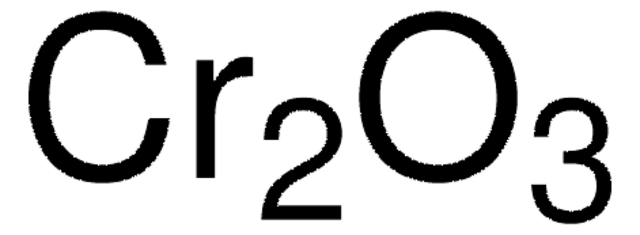266264
Chromium
powder, 99.5%, −100 mesh
Sinonimo/i:
Cd
Autenticatiper visualizzare i prezzi riservati alla tua organizzazione & contrattuali
About This Item
Formula empirica (notazione di Hill):
Cr
Numero CAS:
Peso molecolare:
52.00
Numero CE:
Numero MDL:
Codice UNSPSC:
12161600
ID PubChem:
NACRES:
NA.22
Prodotti consigliati
Livello qualitativo
Saggio
99.5%
Stato
powder
Impiego in reazioni chimiche
core: chromium
reagent type: catalyst
Resistività
12.7 μΩ-cm, 20°C
Dimensione particelle
−100 mesh
P. ebollizione
2672 °C (lit.)
Punto di fusione
1857 °C (lit.)
Densità
7.14 g/mL at 25 °C (lit.)
Stringa SMILE
[Cr]
InChI
1S/Cr
VYZAMTAEIAYCRO-UHFFFAOYSA-N
Cerchi prodotti simili? Visita Guida al confronto tra prodotti
Applicazioni
Chromium powder can be used in the microwave assisted synthesis of a bis(toluene)chromium boron complex, [Cr(η-C6H5CH3)2]+ (BPh4)-. It can also be used in the solid-state synthesis of chromium sulfide.
Codice della classe di stoccaggio
11 - Combustible Solids
Classe di pericolosità dell'acqua (WGK)
nwg
Punto d’infiammabilità (°F)
Not applicable
Punto d’infiammabilità (°C)
Not applicable
Dispositivi di protezione individuale
Eyeshields, Gloves, type N95 (US)
Scegli una delle versioni più recenti:
Possiedi già questo prodotto?
I documenti relativi ai prodotti acquistati recentemente sono disponibili nell’Archivio dei documenti.
I clienti hanno visto anche
Synthetic reactions using metal powders under microwave irradiation.
Whittaker A G and Mingos D M P
J. Chem. Soc., Dalton Trans., 21, 3967-3970 (2002)
Microwave-assisted solid-state reactions involving metal powders.
GavinaWhittaker A and Michael P aMingos D
J. Chem. Soc., Dalton Trans., 12, 2073-2079 (1995)
J A J Vanoirbeek et al.
Journal of toxicology and environmental health. Part A, 66(4), 393-409 (2003-01-30)
Chromium-based catalysts are used for the synthesis of polyethylene, but little is known about the hazard and biomonitoring possibilities of this type of chromium for workers who may be occupationally exposed to such compounds. Therefore, the bioavailability and toxicokinetics of
B Seifert et al.
Journal of exposure analysis and environmental epidemiology, 10(2), 103-114 (2000-05-03)
The German Environmental Survey (GerES) is a large-scale population study which has repeatedly been carried out in Germany. GerES I was conducted in 1985/1986 followed by GerES IIa in 1990/1991 (West Germany) and GerES IIb in 1991/1992 (East Germany). GerES
A J Hart et al.
The Journal of bone and joint surgery. American volume, 95(8), 678-685 (2013-04-19)
Determining the relationship between clinical factors and engineering analysis of retrieved hip implants can help our understanding of the mechanism of device failure. This is particularly important for metal-on-metal hip arthroplasties because the most common cause of failure is unexplained.
Il team dei nostri ricercatori vanta grande esperienza in tutte le aree della ricerca quali Life Science, scienza dei materiali, sintesi chimica, cromatografia, discipline analitiche, ecc..
Contatta l'Assistenza Tecnica.









